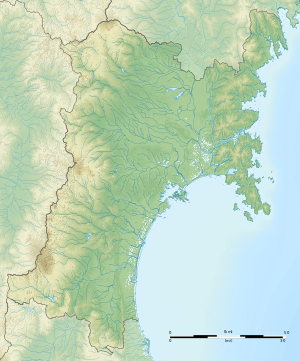Natori River
| Natori River | |
|---|---|
 Mouth of the Natori River in Sendai | |
 Location of the mouth in Japan  Natori River (Japan) | |
| Native name | 名取川 |
| Country | Japan |
| Physical characteristics | |
| Main source |
Ōu Mountains 1,356 m (4,449 ft) |
| River mouth |
Sendai Pacific Ocean 0 m (0 ft) 38°10′N 140°57′E / 38.167°N 140.950°ECoordinates: 38°10′N 140°57′E / 38.167°N 140.950°E |
| Length | 55 km (34 mi) |
| Discharge |
|
| Basin features | |
| Basin size | 939 km2 (363 sq mi) |
The Natori River (名取川 Natorigawa) is a river located in central Miyagi prefecture, in the Tōhoku region of northern Japan. It starts at Mount Kamuro in the Ōu Mountains and flows in an easterly direction through the cities of Natori and Sendai.[1] The river's headwaters start in the Zao Mountain range, it flows through the Sendai Plain and ends by draining into Sendai Bay.[1] The river's estuary is located on Japan's east coast, and faces the Pacific Ocean.[2] The river's flow is the greatest during the snow melt season from March – April, the rainy season from June – July and during the typhoon season from September – October.[3] The river's length is 55 km, and its tributaries are the Hirose, Masuda and Goishi Rivers.[3] The Natori provides water for 1 million people in the city of Sendai.[3]
Basin
The river's basin is 939 km2[3] and has two primary reservoirs, the Okura dam reservoir and the Kamafusa Dam reservoir, both of which serve as regulators of flood control and for the supply of water.[3] In the event of the river flooding, the dams serve to control and reduce water flow to lower basins.[3]
References
- 1 2 GIS and Remote Sensing in Hydrology, Water Resources and Environment - Google Books
- ↑ Hariat, Feril (et al.) (2012). "Morphological Change After the Tsunami Around Natori River Mouth" (PDF). The Disaster Control Research Center, Graduate School of Engineering, Tohoku University. Retrieved September 23, 2012. * Utamakura, Allusion, and Intertextuality in Traditional Japanese Poetry - Professor Edward Kamens - Google Books
- 1 2 3 4 5 6 "Natori-gawa" (PDF). Innovative Disaster Prevention Technology and Policy Research Lab, Disaster Management for Safe and Secure Society Research Division, Disaster Prevention Research Institute, Kyoto University. Retrieved September 23, 2012.
| Wikimedia Commons has media related to Natori River. |